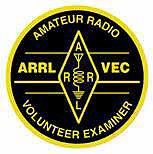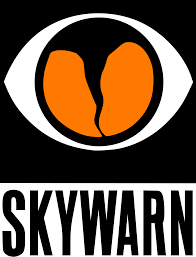Amateur Radio is unique from other hobbies in that being licensed carries certain duties and authority extended to it in the name of public safety.
Unlike other hobbies that are licensed (hunting, fishing, pilots, and others), amateur radio operators are given special privileges during emergencies solely because of the unique nature of our hobby.
We are governed by Title 47, Part 97 (which we normally just refer to as Part 97) which explicitly states: (a) Recognition and enhancement of the value of the amateur service to the public as a voluntary noncommercial communication service, particularly with respect to providing emergency communications.
Most of us know about our charge to use our skills to provide assistance in an emergency. But did you know the law actually empowers us to operate outside of the Amateur Band during emergencies? To be clear, to be classified as an “emergency” life and/or property must be in
immediate danger. That being said, Part 97.111 actually includes language that authorizes communications on other FCC regulated services, communication with government stations, and transmissions to establish contact with other stations outside the Amateur Band.
§97.111 Authorized transmissions. (a) An amateur station may transmit the following types of two way communications: (2) Transmissions necessary to exchange messages with a station in another FCC-regulated service while providing emergency communications; (3) Transmissions necessary to exchange messages with a United States government station, necessary to providing communications in RACES; and (b) In addition to one-way transmissions specifically authorized elsewhere in this Part, an amateur station may transmit the following types of one-way communications: (2) Brief transmissions necessary to establishing two-way communications with other stations; (4) Transmissions necessary to providing emergency communications;
Amateur Radio is so strongly viewed as an emergency communications resource that there is an entire “Sub-Part” of Part 97 called “SubPart E -- Providing Emergency Communications.” This sub-part itself has 4 sections concerning Operation During a Disaster, Safety of Life and Protection of Property, Station in Distress, and Radio Amateur Civil Emergency Service (RACES).
Operation during a disaster
Under §97.401, Operation During a Disaster, an Amateur Radio Operator may make “transmissions necessary to meet essential communication needs and facilitate relief actions.”, even outside the Amateur Band. Unfortunately, what is meant by “relief actions” and “essential communications” is not specifically defined.
The lack of specific definitions is not an accident. The nature of emergencies is that they are unexpected and difficult to plan for. As a result, strict definitions of what “relief actions” or “essential communications” would quite likely not address the circumstances of all possible emergencies. What is needed is the exercise of good judgment.
Safety of life and protection of property
§97.403 No provision of these rules prevents the use by an amateur station of any means of radio communication at its disposal to provide essential communication needs in connection with the immediate safety of human life and immediate protection of property when normal communication systems are not available.
§97.403 essentially throws the rest of Part 97 out the window should issues of safety and protection be presented. This section give broad authority to the Amateur Radio Operator to use “any means of radio communications” at the operator’s disposal.
So how to decide if the criteria is met to operate outside the Amateur Band? Given no other guidance, the rule of “life and limb” in immediate danger is a good start. If a person is at risk of serious injury or death then communications necessary to secure aid would most certainly constitute “essential communications”.
What about property? Is the destruction of an automobile, lawn tractor, or even a home a good reason to operate out of band? There is little guidance here. Personally, I'd think the property destruction would have to be potentially very significant to operate out-of-band. Odds are, if all communications are out and property is being damaged, First Responders are probably overloaded and focused on saving lives. Operating out of band while they are attempting to operate could impede their response to others.
Then there is one other restriction: normal communications must also be unavailable. A “life and limb” situation is not, alone, enough reason to operate outside your license if other conventional communications, such as land-line or cell phone, is functioning. You, quite literally, must be out of other options, or operating at the authority of an authorized government entity, to operate out of band.
Station in distress
§97.405 (a) No provision of these rules prevents the use by an amateur station in distress of any means at its disposal to attract attention, make known its condition and location, and obtain assistance.
(b) No provision of these rules prevents the use by a station, in the exceptional circumstances described in paragraph (a) of this section, of any means of radio communications at its disposal to assist a station in distress.
§97.405, Station in Distress, similarly rescinds provisions of Part 97 in the situation that an Amateur Radio Operator is herself, or another Amateur Radio Operator, in distress.
If an amateur radio operator is himself or herself in distress or is in contact with another who is, and no other means of seeking help exists, then the operator is clear to use whatever radio communications capability is available to seek relief.
Radio Amateur Civil Emergency Service (RACES)
§97.407 (a) No station may transmit in RACES unless it is an FCC-licensed primary, club, or military recreation station and it is certified by a civil defense organization as registered with that organization. No person may be the control operator of an amateur station transmitting in RACES unless that person holds a FCC-issued amateur operator license and is certified by a civil defense organization as enrolled in that organization.
(b) The frequency bands and segments and emissions authorized to the control operator are available to stations transmitting communications in RACES on a shared basis with the amateur service. In the event of an emergency which necessitates invoking the President's War Emergency Powers under the provisions of section 706 of the Communications Act of 1934, as amended, 47 U.S.C. 606, amateur stations participating in RACES may only transmit on the frequency segments authorized pursuant to part 214 of this chapter.
(c) An amateur station registered with a civil defense organization may only communicate with the following stations upon authorization of the responsible civil defense official for the organization with which the amateur station is registered:
(1) An amateur station registered with the same or another civil defense organization; and
(2) A station in a service regulated by the FCC whenever such communication is authorized by the FCC.
(d) All communications transmitted in RACES must be specifically authorized by the civil defense organization for the area served. Only civil defense communications of the following types may be transmitted:
(1) Messages concerning impending or actual conditions jeopardizing the public safety, or affecting the national defense or security during periods of local, regional, or national civil emergencies;
(2) Messages directly concerning the immediate safety of life of individuals, the immediate protection of property, maintenance of law and order, alleviation of human suffering and need, and the combating of armed attack or sabotage;
(3) Messages directly concerning the accumulation and dissemination of public information or instructions to the civilian population essential to the activities of the civil defense organization or other authorized governmental or relief agencies; and
(4) Communications for RACES training drills and tests necessary to ensure the establishment and maintenance of orderly and efficient operation of the RACES as ordered by the responsible civil defense organization served. Such drills and tests may not exceed a total time of 1 hour per week. With the approval of the chief officer for emergency planning in the applicable State, Commonwealth, District or territory, however, such tests and drills may be conducted for a period not to exceed 72 hours no more than twice in any calendar year.
§97.407 provides guidelines for operation of amateur radio emergency service organizations that report directly to local, state, and national civil emergency management entities such as your local Emergency Management Agency (EMA), Georgia Emergency Management Agency (GEMA), and the Federal Emergency Management Agency (FEMA).
Extensive and specific regulations concerning the operation and inter-operation of Radio Amateur Civil Emergency Service (RACES) stations are included in this section.
Included in this section are regulations allowing the FCC to extend the frequencies this group may use and to provide EMAs the ability to authorize RACES participants to operate on frequencies used within their jurisdiction.
The Amateur Radio Emergency Service (ARES), an ARRL sponsored organization is largely identified as the go-to organization for amateur radio emergency communications. When an Emergency Management entity enters into an agreement with ARES, a provision enlisting some or all ARES members into RACES is usually included. In essence, in many jurisdictions ARES functions as the RACES organization.
Other considerations
The rules of out-of-band operation may not be quite as significant as they once were. Many Public Safety entities no longer operate on analog frequencies in a frequency range our radios are capable of tuning to, even when modded to operate outside our band.
Many jurisdictions operate on trunking systems that “frequency hop” and may also operate in digital modes. In some cases the local Fire Department or Ambulance Service may still operate on VHF frequencies our equipment could reach.
While it is unlikely we'll ever need to operate in such a way, investigating the out-of-band frequencies in use by the local Public Safety entities we can communicate on is clearly a prerequisite to being prepared in the event the need arises.
Conclusion
In conclusion, amateur radio operators are authorized to use a wide range of frequencies across multiple bands to enjoy experimenting and communicating with amateur radio. We are encouraged, in return for these allocations, to be prepared to provide emergency communications services to the public in time of emergency.
In order to achieve these goals we are given extraordinary privileges to operate in modes and bands our license ordinarily does not allow during times of emergency. However, discretion is required.
Discussion
What level of property loss would rise to the level to warrant operating out of band? Would it depend upon the nature of the emergency or disaster?




